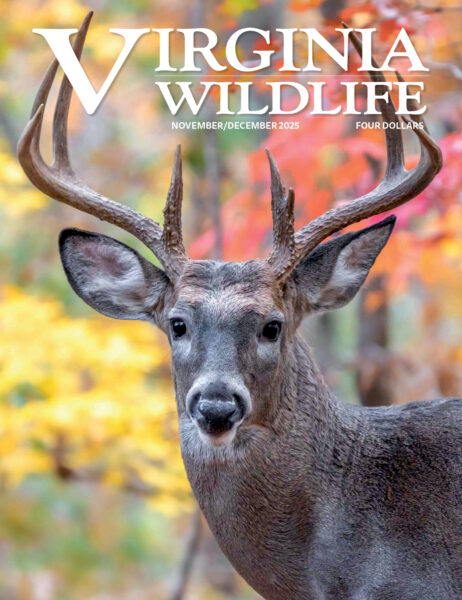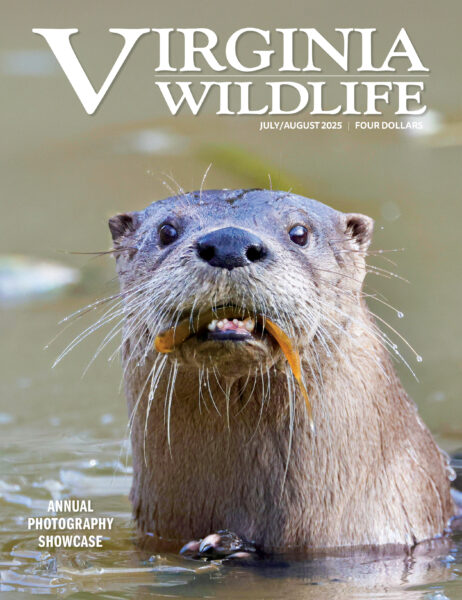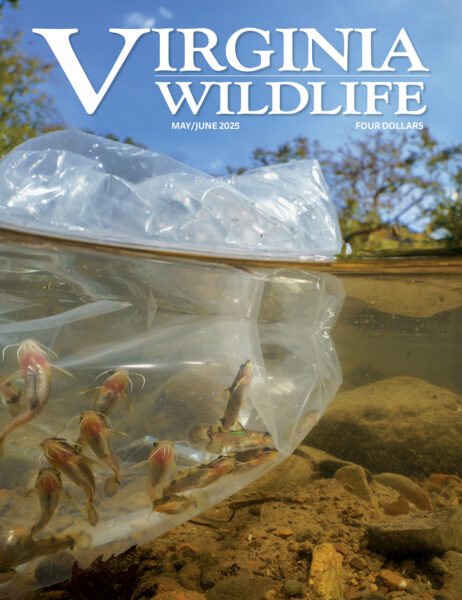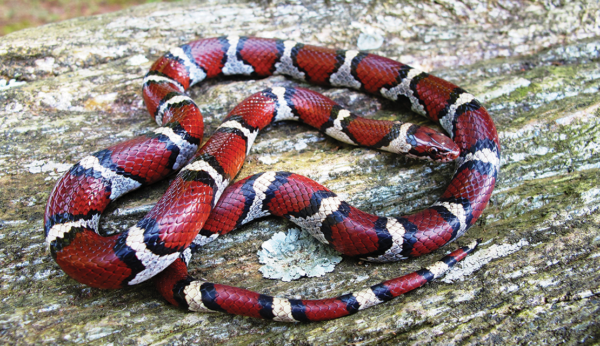
Kingsnake © JD Kleopfer
Every October 21st is National Reptile Awareness Day, a day created to promote education, conservation and appreciation for reptiles. Reptiles are a group of animals that include snakes, lizards, turtles, crocodiles, and tuataras. Reptiles are characterized by having dry scales that are shed periodically. The vast majority of reptiles are cold blooded, which means that they cannot generate their own body heat and depend on outside sources to raise their body temperature.
In honor of Reptile Awareness Day, we are celebrating Virginia’s snakes, a group of reptiles which play an important role in our environment, but are often misunderstood. There are 32 species of snakes in the Commonwealth, of which, the vast majority are considered harmless. Snake species occur across Virginia, from coastal marshes to mountain ridgetops and even in urban areas under buildings. There are only 3 species of venomous snakes occurring in the Commonwealth: Northern Copperhead, Eastern Cottonmouth, and Timber Rattlesnake.
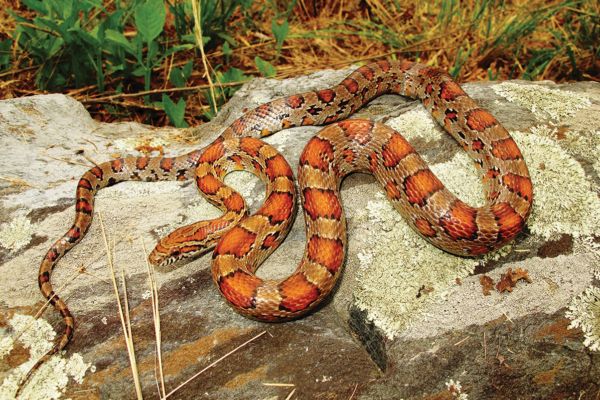
An image of a corn snake © JD Kleopfer
Snakes differ from other reptiles by having no legs, ears, or eyelids, and by possessing only one functional lung. The most notable characteristic of a snake is its long, slender body. A snake’s muscular body and flexible spine allows it to climb effortlessly, swim, and slip into the smallest spaces. Although snakes lack ears and cannot technically hear, they do have the ability to detect low frequency vibrations from the air and ground.
Depending on the species, Virginia’s snakes may mate in the spring, summer, or fall.
Leathery shelled eggs are usually deposited in May or June, with young hatching in late summer. But not all snakes lay eggs; the young of many of Virginia’s snakes are actually born alive. With young that are born alive, the eggs are held inside the body and live young are born in late summer.
Snakes play important roles as predators and prey. All snakes are carnivorous, which means that they eat other animals and do not eat plants. Snakes possess the special ability to
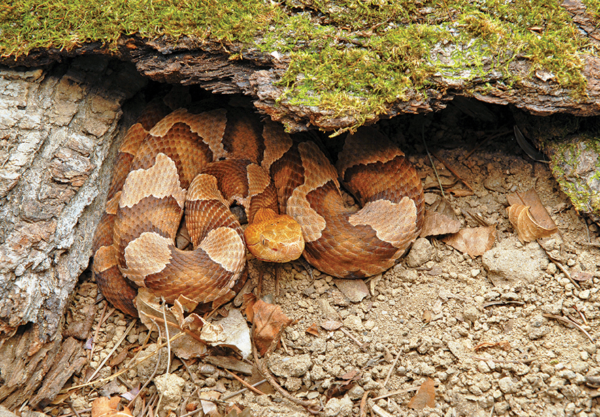
Copperhead © John White
swallow their prey whole because they have two independent lower jaws connected by a ligament that can expand greatly. Major prey items include invertebrates (animals lacking a backbone), fish, amphibians, other reptiles, birds, bird eggs, and a variety of mammals. Snakes play an invaluable role in our environment by controlling many pests, including mice and rats. Snakes also play a key role in the web of life; they are food for a variety of predators including certain mammals, birds, and other snakes.
Snake Conservation
The greatest predators of snakes are humans. Misconceptions about snakes have made them among the most persecuted of all animals. Hundreds, if not thousands, are needlessly killed every year in the Commonwealth. A common reaction to an encounter with a snake is to kill
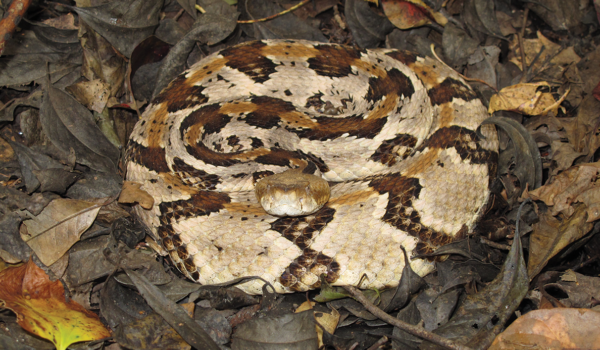
State Endangered Canebrake Rattlesnake. Photo by J.D. Kleopfer.
it on sight whether or not it poses a danger. However, the fact is that most snakes are harmless, and even dangerous ones would rather flee than fight. Once we begin to learn about snakes, we can replace our misconceptions with facts and our fears with curiosity, and we can begin to appreciate their important roles in our natural environment.
Fourteen of Virginia’s 32 snake species are included in Virginia’s Wildlife Action Plan as Species of Greatest Conservation Need, including the State Endangered Canebrake Rattlesnake (the southeastern Virginia population of Timber Rattlesnake) and the Northern Pinesnake. A century ago, the Northern Pinesnake was considered common in several parts of Virginia, but there have been no sightings of this species in the last 25 years, so it’s been presumed extirpated from the Commonwealth. The extirpation of this species is most likely due to fire suppression, habitat
loss and fragmentation, and human persecution. The Department of Wildlife Resources (DWR) recently participated in an investigative study that demonstrated Northern Pinesnake habitat (dry open slopes with vegetated cover) is still available in Virginia and that it would be feasible to reintroduce this endangered species into its historic range.
Simple ways to help conserve and protect snakes and other reptiles:
- Support efforts to establish and protect natural areas.
- Provide habitat for wildlife on your own property by keeping portions of it unmowed and ungrazed and by planting native plants.
- Reduce your use of fertilizers and pesticides in your yard and garden.
- Recycle and do not litter or pollute.
- Join a conservation organization.
- Make a contribution to DWR’s Nongame Wildlife Fund.
- Do not kill snakes.
- Keep learning about snakes and teach others what you learn, so that all may appreciate this unique group of Virginia’s wildlife. More information on Virginia’s snakes may be found in these resources:
- DWR’s A Guide to the Snakes of Virginia
- Virginia Herpetological Society’s Snakes of Virginia webpage

This article originally appeared in Virginia Wildlife Magazine.
For more information-packed articles and award-winning images, subscribe today!
Learn More & Subscribe


